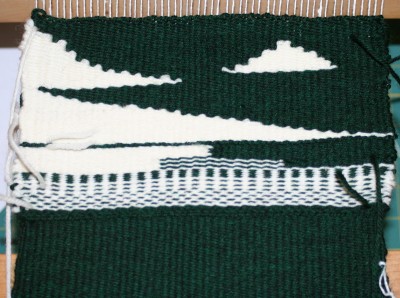Yesterday (before reading Amelia’s comment/suggestion) I decided to give tapestry weaving another shot. So I cut off my first sample, and re-sleyed at 6 epi. (I have a 10 epi reed and a 6 epi reed, so 6 epi was a natural choice.) This worked a lot better, so I sat down and wove this:

The weave is a little looser than I’d like, and according to Amelia’s method I should really be weaving at 8 dents per inch, so I’m contemplating ordering an 8-dent reed. (I don’t think an uneven sleying will “wash out”, since as far as I know tapestry isn’t wet-finished.) I sort of hate to order one for a single use (normally I weave much finer than that), but it would be nice to be able to try a denser sett. I may see if one of the loom manufacturers has scraps lying about; all I need is a 9″ length.
At any rate, I have now gone through about half the lessons in Kirsten Glasbrook’s book, and am eagerly looking forward to finishing them! Once I complete that I may do one or two of her “practice projects” (which come complete with detailed instructions) before doing my samples for the COE. (I definitely need more practice; my selvedges are not nearly as clean as I’d like, and some of my horizontal lines/rows are a bit wonky.)
I did a preliminary test using my new dyeing setup, with blotchy results, primarily due to my trying some shortcuts. I’m going to do another test today, this time actually stirring the dyebath along the way, and see if that works.